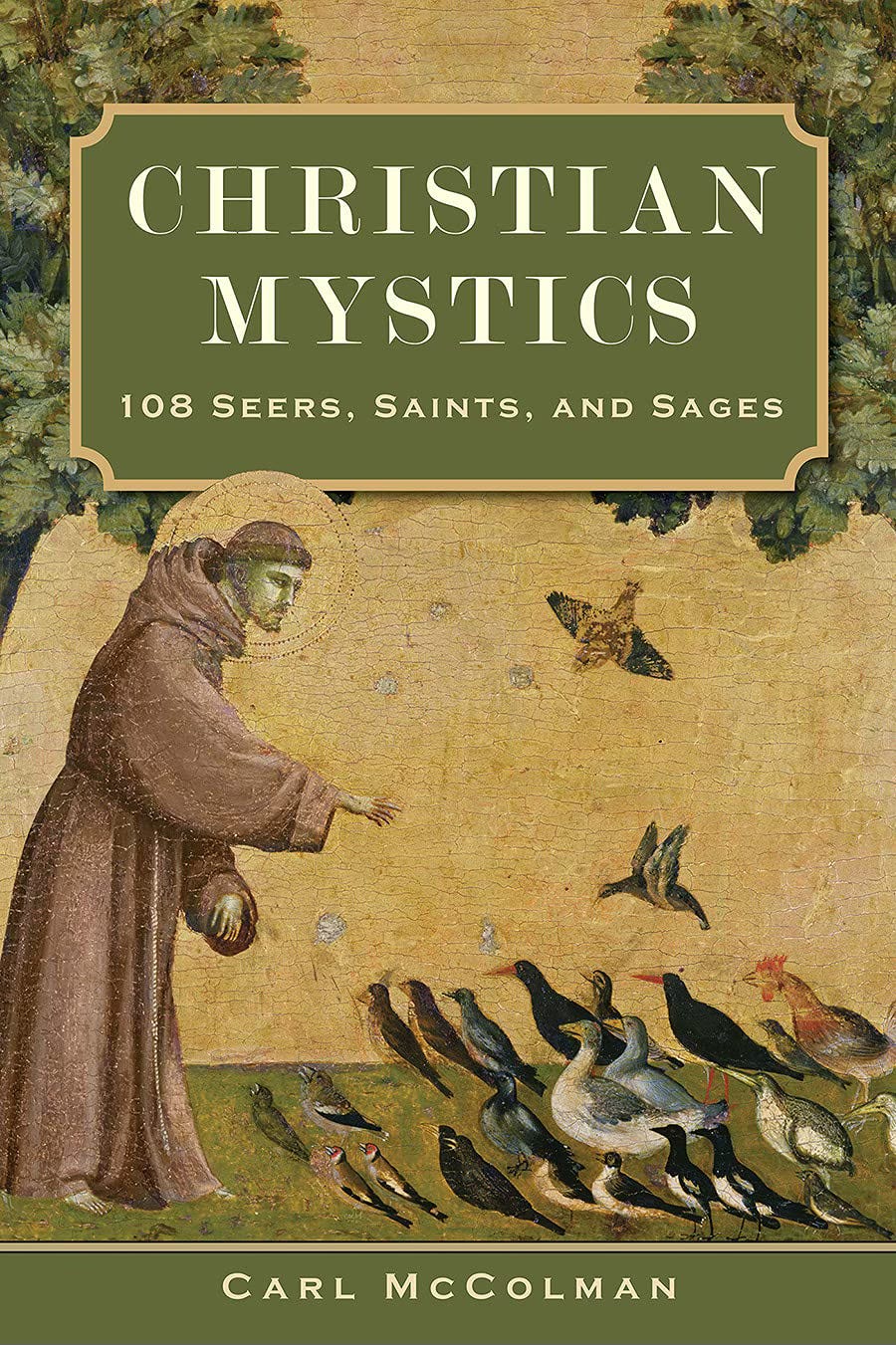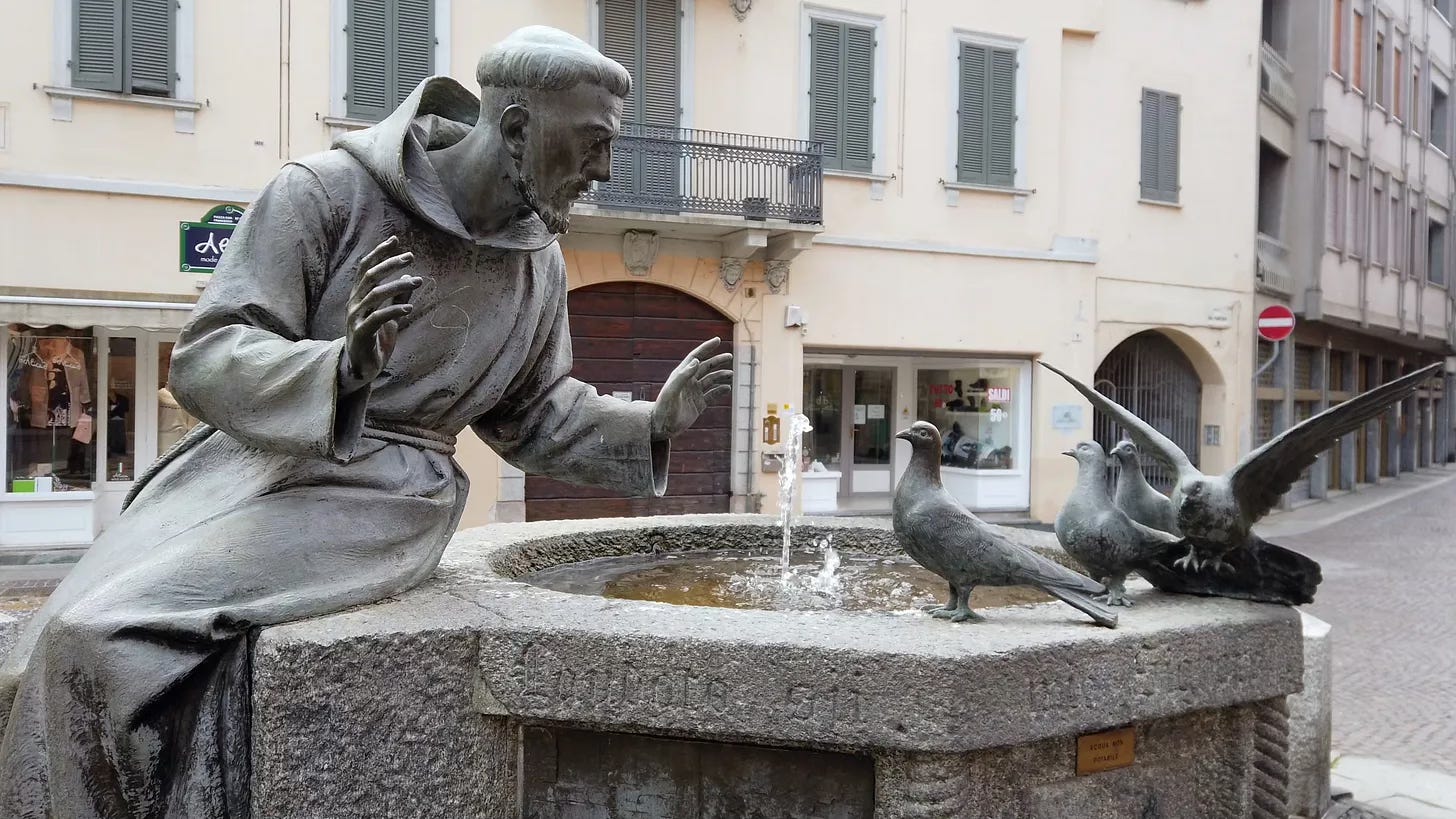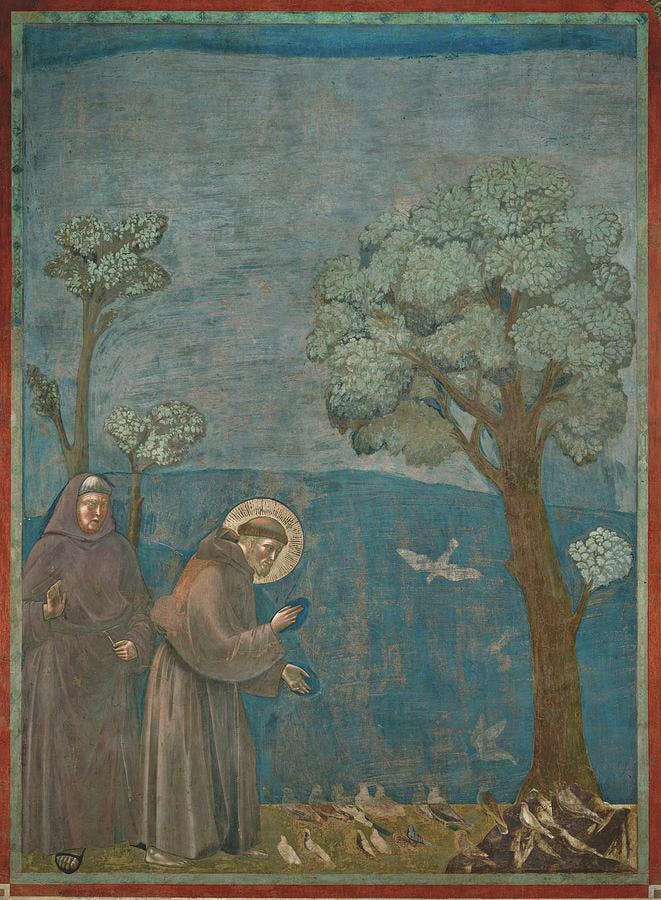Brother Saint, Sister Hippie
Why does it seem like just about everybody loves Francis of Assisi?
Today, October 4, is the feast day of Saint Francis of Assisi, who died 799 years ago this week. Check with your local Catholic or Episcopal Church; they are likely hosting “blessing of the animals” service this weekend, in honor of the legends surrounding Francis — as someone who loved and preached to birds, deer, and even wolves. You’re more likely to find just cats and dogs at a contemporary blessing service, although don’t be surprised if a cockatoo or iguana or even a boa constrictor shows up. In Francis’s world, all animals are welcome.
Francis is that rare kind of mystic: not only is he one of the most popular and highly venerated of Catholic saints, but he is a figure who appeals both to traditionalists and to progressives.
Born sometime around the year 1181, Giovanni di Pietro di Bernardone was the scion of a wealthy silk merchant, and might easily have spent his days living the carefree life of affluence and privilege. He was attractive and well-dressed, and had an interest in the troubadours (probably the closest equivalent in his age to a rock star).
Then when he joined a local militia seeking, perhaps, to prove himself in battle (or at least to win the admiration of family and friends), things went terribly awry; during a battle between the residents of Assisi and nearby Perugia, he was taken prisoner and held in miserable conditions; his father had to pay a ransom to get him back home and he spent quite some time ill. Eventually he returned to his bourgeois life, but it may well be that the seeds of his spiritual awakening had already been planted within him.
Two years after his release from captivity, Francis considered joining another military expedition, but received a vision that dissuaded him from further worldly ambition. Then, in an abandoned church in the San Damiano countryside about 2 kilometers from Assisi, he received a locution from Jesus, instructing him to repair his church, “which as you can see has fallen into ruin.” Taking this literally, Francis assumed he was being put in charge of restoring the old chapel — and promptly helped himself to some merchandise from his father’s business to bankroll his new endeavor. When a priest heard of this and objected to Francis’s questionable ethics, he became indignant.
Even future great saints have to get over their capacity for selfishness
Eventually a climactic moment arrived when Francis’s father, furious at his son’s increasing interest in (or obsession with) spiritual matters — and his increasing tendency to give generously to the poor — had him arrested, beaten, and imprisoned in the family home in an effort to regain control over the youth. Francis’s mother set him free, but then the father asked for a hearing in front of the local bishop, where he intended to disinherit Francis. But the youth was one step ahead of him. In front of the bishop and all the surprised onlookers, Francis stripped off his expensive clothes, returning them and whatever money he had in his possession, back to his father (the bishop, perhaps scandalized and perhaps impressed by Francis’s emergent faith, discreetly covered him with his own cloak).
From there Francis gathered companions, friends who joined him in a shared devotion to Christ that inspired them to live simply and care for those in need — an association that became the headwaters of the Franciscan order. It was not long before a community of women, following the lead of a young noblewoman named Clare, formed a “second order” of Franciscans, who eventually came to be known as Poor Clares. And even in Francis’s own lifetime, he helped to organize laypeople, who had no call to consecrated religious life but who wanted to orient their spirituality according to Franciscan principles, into a “third order” also known as secular Franciscans (several great mystics have been secular Franciscans, including Angela of Foligno, Bridget of Sweden, Catherine of Genoa and Francis de Sales; not to mention mystical poets like Dante and Coventry Patmore, or musicians like Franz Liszt and John Michael Talbot).
Fast forward to our time. If you enjoy the contemplative wisdom of Richard Rohr and Ilia Delio — two of the most acclaimed spiritual writers living today — you are being nurtured by the ongoing charism of the Franciscan tradition.
Conservatives love Francis. So do liberals. How did that happen?
I’ve already noted that I admire Francis for his ability to inspire both conservatives and liberals. Let’s take a closer look at that.
It’s easy enough to see the conservative appeal. Francis was a Catholic’s Catholic, deeply loyal to the institutional Church and careful to shepherd his own movement so that it stayed within the guardrails; he worked hard to make sure the Order of Friars Minor received approval from the Pope as a recognized religious community. Today, Franciscans rank alongside Jesuits, Benedictines, Dominicans and Trappists as one of the most respected of Catholic consecrated orders. Francis’s care for the poor and his love for the natural world is regarded by conservatives, as evidence of his sanctity, but not seen as subversive of the authority of the Church.
But Francis also inspires those, both inside and outside the Catholic Church, who would never be accused of being conservative or traditionalist. It has been said that Francis of Assisi was the worlds’ first hippie (an idea immortalized in the saccharine 1972 movie Brother Sun Sister Moon). Eight centuries before the Grateful Dead started taking acid, Francis consciously “dropped out” of his family’s affluent lifestyle, opting instead for a life of simplicity geared toward serving those who were less fortunate. Meanwhile, numerous legends testify to Francis’s reputation as a great lover of animals and nature, leading him to be regarded as a patron saint of the environment (officially being declared as such by Pope John Paul II).
So, was Francis a hardcore Catholic saint, or a medieval prototype of a tree-hugging, anti-capitalist mystic? My sense is the answer depends on the eyes of the beholder. As someone who is able to appreciate both of these ways of approaching Francis, I marvel at how someone who lived so long ago can be so inspirational to such a wide variety of spiritual seekers in our time. That’s something to pay attention to.
One of the many fascinating stories about Francis involved his journey to Egypt in 1219 to meet with a Muslim ruler, Sultan Malik al-Kamil, during the fifth crusade, petitioning the sultan to join with him in standing for peace rather than war. Legend holds that the Malik al-Kamil was so impressed by Francis’s sincerity and holiness that not only did he secure safe passage for the Italian to return home, but then also took steps to insure that any Christian prisoners of war under his authority were treated with dignity.
To conservatives, this is an example of a courageous missionary act: Francis “preaching” the Gospel by example to a hostile Muslim leader. But to liberals, it is an early incidence of constructive interfaith dialogue, where Francis’ actions centered not so much on the proclaiming the “truth” of one religion to adherents of another, but rather an example of a more open-hearted encounter were the practitioners of two different faiths encountered each other in a spirit of mutual respect and understanding, seeking common ground rather than merely competing with each other.
Once again, it seems that the way we interpret this singular event depends largely on the eye of the beholder. And what I suppose we might take away from this is a recognition that someone with the obvious simplicity, sincerity and compassion of St. Francis is capable of inspiring people with a wide variety of values and views. Perhaps the spiritual lesson for all of us today is to be authentic, to be kind, to be compassionate toward those who have less than we do, and to treat the natural world with respect. Hopefully these are values that are bigger than any one school of theology or political persuasion.
A popular prayer that begins “Lord, make me an instrument of your peace” has been attributed to Francis — but in fact, this prayer was first published only in 1912, with no evidence that St. Francis had anything to do with it. But as for writings we can more reliably atttibute to the troubadour from Assisi, the best known is the Canticle of the Sun, which is alluded to in the name of that 1972 movie. Here are a few excerpts, from an English translation by the Franciscan Friars Third Order Regular:
Be praised, my Lord, through all your creatures,
especially Sir Brother Sun,
who brings the day; and you give light through him.
And he is beautiful and radiant in all his splendor!
Of you, The Highest, he bears the likeness.
Praised be You, my Lord, through Sister Moon and the stars,
in heaven you formed them clear and precious and beautiful.
Praised be You, my Lord, through Brother Wind,
and through the air, cloudy and serene,
and every kind of weather through which you give sustenance to Your creatures.
Praised be You, my Lord, through Sister Water,
which is very useful and humble and precious and chaste.
Praised be You, my Lord, through Brother Fire,
through whom you light the night and he is beautiful
and playful and robust and strong.
Praised be You, my Lord, through Sister Mother Earth,
who sustains us and governs us and who produces
varied fruits with colored flowers and herbs.
Deeply elemental and imbued with a sense of wonder and devotion at the many blessings of the natural world, it would not take much editing to turn this into a hymn of praise that a coven of Wiccans could use in one of their circles — but when you consult the Canticle in its entirety you’ll find references to mortal sin, humility, and doing God’s will: the kind of language that conservatives typically are more likely to affirm and use. So yet again, the hippie is also a saint, the one who loved birds and wolves also the inspiration for the Argentinian Jesuit cardinal Jorge Bergoglio, who (thanks to his devotion to caring for the poor) took the name Francis when he was elected pope in 2013. Pope Francis may have been the first pontiff bold enough to take the name of Il Poverello (the “poor man”), but I suspect he won’t be the last.
So was Francis a radical, a reformer, or simply a dedicated Roman Catholic? It seems he was all of the above. In today’s fractious world, many of us not be willing to (or in a position to) do what it takes to be loved and respected by people from all sides. That’s not so much an indictment on us as it is a reminder of why Francis is truly a singular and amazing figure. We do not have to imitate him slavishly, but perhaps we do need to listen for the whisper of eternity when it emerges from deep within our heart. If we do that, we will receive a call; it may not involve stripping naked in the public square (!), but it will involve taking a stand for life, for compassion, for care, and for hope.





